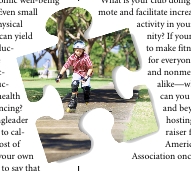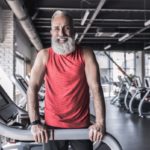
Cody Sipe, PhD
Cody Sipe, PhD
Article Archive
How can you “cognify” exercises to give your clients a big kick in the hippocampus? The basic ideas here can help you integrate cognitive stimuli into most exercises.
Read MoreThe aging of the global population is single-handedly forcing and inspiring change in many ways—both obvious and subtle. The continued growth of the older population for the next 30+ years will influence the fitness industry in ways that we probably can’t even imagine yet. To help you prepare for this growth, here are some noteworthy aging trends (counting down from least to most important from a business standpoint) that could affect you over the next 5–10 years.
Trend #5: Brain Fitness Comes of Age
Read MoreExercise is good for promoting brain health. Indeed, the right kind of exercise can protect against the natural decline of brain.
Read MoreThe aging of the global population is single-handedly forcing and inspiring change in many ways—both obvious and subtle. The continued growth of the older population for the next 30+ years will influence the fitness industry in ways that we probably can’t even imagine yet. To help you prepare for this growth, here are some noteworthy aging trends (counting down from least to most important from a business standpoint) that could affect you over the next 5–10 years.
Trend #5: Brain Fitness Comes of Age
Read MoreStudy after study shows that physical activity, diet and other lifestyle factors keep the brain healthy as we age—contrary to the popular notion that cognitive function inevitably declines in the later years of life.
Read MoreWhy tai chi?
These Chinese movement patterns have been around for centuries. In recent years, study after study has proven the benefits of tai chi—particularly for older exercisers—yet most fitness professionals seem to know little about it.
That’s too bad, because just about any fitness client can learn tai chi, and any fitness professional can teach it. Like other types of exercise, tai chi simply requires you to learn its movements and experience its benefits.
At what age does a person become old? Is it 50 or 65 or 75? I've known healthy 75-year-olds who could outrun, outswim and outlift me, and I've known diseased 60-year-;olds who'd be short of breath walking to the mailbox.
Read MoreThe aging of our global population and the significant increase in numbers predicted over the next 20–30 years (Pew Research Center 2009) offers a unique opportunity and challenge for fitness professionals. When it comes to training older adults, we must look at what we’ve been doing, evaluate its effectiveness and move forward with ideas and…
Read MoreElite trainers have in-depth knowledge and skill in their area of expertise and know how to communicate information effectively to their clientele. While some trainers may seem blessed with an ability to communicate well, most of us need to work hard at it. One critical communication skill that takes practice and that most elite trainers need at some point in their careers is cuing.
Read MoreDressed in a long-sleeve T-shirt and blue sweat pants, tall, thin, silver-haired trackster Everett Hosack of Chagrin Falls, Ohio, clocked a world indoor record (27.29) in the 60-meter dash for men at the 2002 USA Track and Field Nationals; minutes later, he won the 8.8-pound shot-put event with a toss of 11 feet, 6.75 inches.…
Read MoreToday, older adults represent the largest demographic in the U.S., hold the most discretionary spending power and have a huge interest in anything anti-aging. Professionals …
Read MoreImproving Functional Abilities in Older Adults
Which are the most effective training programs for your mature clients, and how can you best assess their current level of functional ability?
By Cody Sipe, MS
T
The number of people now approaching middle age in America is simply astonishing–and unprecedented in history. It is anticipated that the U.S. population of adults over the age of 65…
Read More


img src=”/files/article_images/20…
Read More










